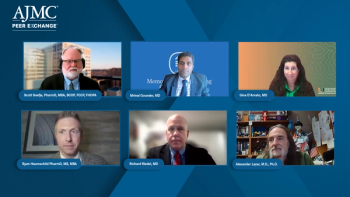
Can Patients Distinguish Volume From Value in Healthcare?
Bruce A. Feinberg, DO: I would challenge you that it may be somewhat inherent in our Western culture that from the patient perspective, volume is value. They want more, they want it to be new. There are things that they want—that’s part of our cultural heritage of “wanting it now,” “wanting more of it,” and “wanting the newest that’s available.” That almost drives the volume argument from a patient perspective.
Alan Balch, PhD: I don’t know that patients, at this point, have been given enough choice and been given the information to differentiate between “more” or “different” options, or choosing between them in a way that really captures my value framework.
So, I think the opportunity that’s before us is to figure out how, in a shared decision-making environment, patients have access, not to information but to knowledge. And that they can express their values in helping to make that treatment selection that really reflects what they want out of care at the individual level. From our perspective, that’s how you get at value. If the end goal of what we’re trying to get to is a system that delivers value, the ultimate consumer in the system is the patient. Having that is sort of the central star with which we’re trying to align—value to the patient—which again gets you into this world of patient centeredness.
At least from the patient perspective, if we’re going to redesign and realign incentives—as well as not just the payment incentives, but the delivery platforms—how do you do that in such a way that it really allows and empowers patients to express their values and make decisions in the healthcare environment that reflect what they’re trying to get out of their care? I would suggest to you that the answer varies from patient to patient. If given that choice and given a system that allows them to do that, I would guess that oftentimes, patients would make different decisions than what you might think that they would make.
Ted Okon, MBA: We’ve been sort of focused on the numerator here; not to get mathematical, but in terms of the quality or outcomes component to this. The cost component is equally as challenging because a lot of times we gravitate right to, literally, the value associated with the drug. And the fact of the matter is [that] there’s a value associated with their overall care, which includes their hospital care, if that’s involved, and their radiology as well. So this is very complex.
And the one thing I would challenge, and I think it’s going to come up in our discussion today when talking about all these calculators and all this other stuff, is that it can’t just be about the drug. Because we, Milliman, commissioned a study that was released recently that shows that your drug piece, which is very important and something that has to be controlled, is only, if you look at the Medicare side, it’s 18%. If you look at the commercial side, on average, it’s 21%. It’s only a piece, about one-fifth, of all the cost that you include when you talk about treating cancer.
Newsletter
Stay ahead of policy, cost, and value—subscribe to AJMC for expert insights at the intersection of clinical care and health economics.







































